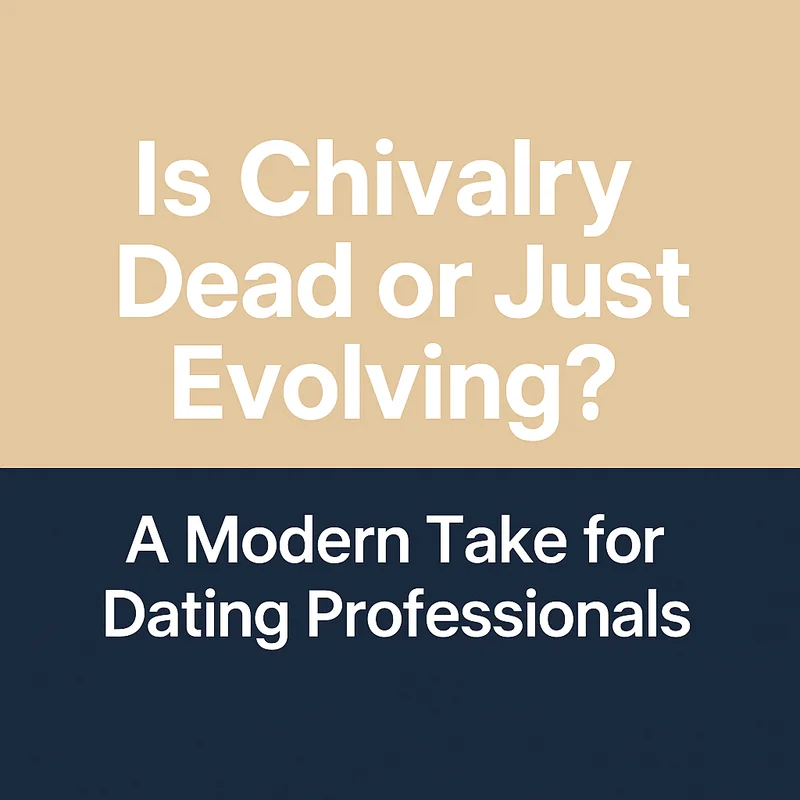
Introduction: Chivalry in the Age of Swipe Culture
Ask any dating professional what clients complain about most, and you’ll likely hear: “Nobody knows how to be respectful anymore.” From ghosting and breadcrumbing to confusing gender expectations, the question many singles are asking is, “Is chivalry dead?”
But what if chivalry isn’t dead—just different? As relationship dynamics evolve, so do the unspoken rules of attraction, courtesy, and gender roles. In this article, we’ll unpack the history of chivalry, explore its modern adaptations, and offer practical insights for dating professionals who guide clients through today’s romantic landscape.
1. The Origins of Chivalry: From Knights to Courting
Before dating apps and love languages, there were knights, castles, and honor codes. The term “chivalry” originated in medieval Europe, referring to a moral and social code upheld by knights. It emphasized bravery, loyalty, and service—especially toward women and the vulnerable.
Key points:
- Chivalry was rooted in a feudal system and often reflected patriarchal values.
- It emphasized protection and provision—qualities that historically defined masculinity.
- Romantic chivalry evolved during the era of courtly love, laying the foundation for modern dating rituals.
As dating professionals, understanding this background helps contextualize how deeply embedded these ideals are in romantic scripts—even when clients aren’t consciously aware of them.
2. The 20th Century Gentleman: A Social Expectation
Fast-forward to the mid-1900s, and chivalry had morphed into a series of gentlemanly gestures: opening doors, paying for dinner, pulling out chairs. These behaviors were widely accepted as signs of good breeding and romantic interest.
Yet, these gestures came with unspoken gender expectations:
- Men were expected to lead, pay, and protect.
- Women were expected to be receptive, appreciative, and passive.
For many clients over 40, this is the model of dating they still believe in—or long for. As a dating professional, recognizing generational differences is essential when giving advice or matchmaking across age groups.
3. Enter Feminism: A Chivalry Reckoning
With the rise of feminist movements in the 1960s and beyond, traditional chivalry came under scrutiny. Critics labeled it benevolent sexism—a polite but limiting form of inequality that implied women needed men to care for them.
Consider this shift:
- A man offering to pay for dinner could be seen as generous… or assuming power.
- A woman declining a chivalrous gesture may not be rude—just asserting equality.
For dating coaches, this means helping clients understand intent and interpretation:
- Is the gesture about respect or control?
- Does it match your date’s values?
Encouraging conversations around expectations can help clients avoid missteps rooted in outdated norms.
4. Is Chivalry Really Dead? What the Data Says
Surveys suggest that while traditional chivalry is fading, its core values—kindness, attentiveness, respect—are still in demand.
Recent findings:
- A 2024 Pew study found that 57% of adults under 35 believe chivalry is “outdated but endearing.”
- 68% of women and 51% of men say they value respectful gestures on a first date, regardless of who initiates them.
- In heterosexual dynamics, most respondents still expect the man to pay on the first date—but more than half of Gen Z say they’re open to splitting the bill.
Takeaway for professionals:
Modern chivalry isn’t about who opens the door—it’s about who opens up emotionally, communicates well, and shows care.
5. Chivalry Reimagined: How to Guide Clients in 2025
The goal isn’t to discard chivalry, but to redefine it through the lens of mutual respect and emotional intelligence. Dating professionals can help clients shift from performing outdated rituals to embracing meaningful gestures.
Encourage modern chivalry like:
- Offering help without assuming need
- Listening actively and validating feelings
- Respecting boundaries and autonomy
- Being punctual, honest, and communicative
- Showing gratitude—regardless of gender
This version of chivalry is inclusive, adaptable, and builds trust—something every client, regardless of orientation or gender, can get behind.
6. Should We Still Teach Chivalry?
This is where dating professionals play a key role. Rather than teaching clients to memorize scripts or rely on gendered etiquette, coach them to:
- Understand their partner’s values
- Communicate clearly and kindly
- Make thoughtful gestures based on personality, not assumptions
Pros of modern chivalry:
- Encourages thoughtfulness
- Reinforces mutual respect
- Enhances emotional connection
Cons if misused:
- Can perpetuate power imbalances
- May confuse or alienate partners with different values
- Risks appearing performative or inauthentic
Bottom line: Chivalry can thrive—if it’s rooted in sincerity, not obligation.
Conclusion: The Future of Chivalry Is Empathy
Chivalry isn’t dead. It’s shedding its armor and donning emotional intelligence.
For dating professionals, the opportunity lies in helping clients embrace this evolution. The best relationships aren’t built on outdated rituals—they’re built on real connection, respect, and thoughtful communication.
So next time a client asks if they should open the door or split the bill, guide them past the etiquette and into a deeper question: What kind of connection are you trying to build?
FAQs
Q1: What does modern chivalry look like in dating today?
A: It involves mutual respect, emotional availability, and kindness—regardless of gender roles.
Q2: Is it sexist to be chivalrous in 2025?
A: Not if the intent is respectful and the action aligns with your partner’s comfort and values.
Q3: Should men still pay on the first date?
A: It depends on the couple. Professionals should advise clients to discuss expectations early and focus on generosity over obligation.



